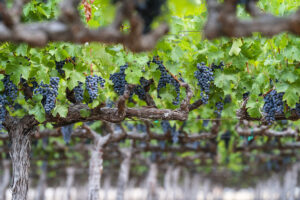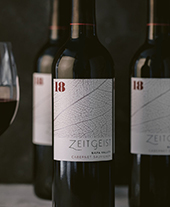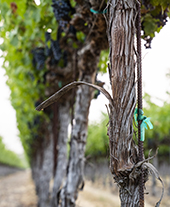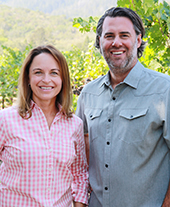Vineyards

The Lewelling Ranch – Cabernet Sauvignon
Along the western hills in St. Helena, lies an incredible patch of dirt for growing Cabernet. This neighborhood has many well-known Cabernet vineyards, and at the heart of it lies Lewelling Ranch. Located just at the base of the Mayacamas range this vineyard sits in an ancient alluvial fan. This fan is part of a historic creek bed, with soils consisting of cobble, creek wash and gravelly sand (known as Cortina). This soil is quick to drain enabling natural management of the moisture in the vine’s microclimate. Wines made from this neighborhood tend to be plush, fruit driven and rich.
Know Your Farmer
A Deep-dive into Lewelling from March 15th, 2025
We’ve all heard of extroverts and introverts, of the loud and the quiet. Herein lies the stories of some of the quiet characters in the fabric of the Napa Valley; not brash, flamboyant or outspoken, but with a rich story that knits together the past, the present and the future of this winegrowing valley.
You, dear reader, are aware of the complexities of growing grapes for wine. It’s known that wine grapes are not a simple commodity. Where they grow and how they’re tended pre-determine the quality of a wine.
In the 1860s, horticulturist John Lewelling moved from California’s East Bay, seeking warmer weather, to purchase and plant land in St. Helena, totaling over 400 acres. After several generations, his family is still quietly maintaining control of much of this land. Along with others, Mr. Lewelling would found the St. Helena Viticultural Club in 1875. When Phylloxera decimated his grapes, he converted the vines to walnuts, almonds, prunes and other stone-fruits, and built a dehydrator on the property for drying fruits.
For parts of the 20th century, much of the vineyard was leased and farmed by others (including the Napa Valley legend Laurie Wood).

John Lewelling — Courtesy of The Napa Valley Register
This Spring, we invited the team behind Lewelling Vineyard over for a casual weeknight dinner. The party included John Lewelling’s great-great-great-granddaughter, Haley Wight Dodd and her husband and our farmer, Erik Dodd. Missing on this fine evening was Haley’s father, Doug Wight, the great-great-grandson of John Lewelling, also our farmer, and the living patriarch of this story. We opened several vintages of Zeitgeist’s “The Grove,” the wine we make from the Lewelling Vineyard. Soon, we will release the 2022 vintage of The Grove, our 9th year making wine from the Lewelling Vineyard.
In the 1970’s, with a Fruit Science Degree from Cal Poly and experience growing grapes for other properties in Napa, Doug Wight took back control of the fruit, nut and grape production at his family’s property. In the decades since, Doug has devoted his life and the ranch to winegrapes. His daughter, Haley and her husband, Erik returned full-time to the Napa Valley in 2004 to live, work, and raise a family.
St. Helena is home to one of the finest alluvial fans in the Napa Valley, and in it lies many famed vineyards. The Lewelling Vineyard may not have the name recognition of Dr. Crane or Madrona Ranch or Spottswoode, but it should. Nestled in the foothills of the Mayacamas mountain range, the Lewelling vineyard is a warm site on soils that would make you squeal with delight if you were into such things (they vary across the ranch but are all weathered loam and gravel).
Vestiges of the Lewelling past are present in the viable businesses still owned by the family; this is not a story of a bygone era, but of a continuation of generations. Of people committed to this land and this community. The life of Mr. Lewelling and his family’s impact in St. Helena is an interesting one, and while we don’t have space for it all here, on this Sunday, if you choose to dig deeper, please consider this article by David Thompson at the Napa Wine Project.

Warehouses on Church Street built by the family in the late 1870’s to house the St. Helena Viticultural Club–courtesy of St. Helena Historical Society
Beyond Agriculture
Haley, an avid naturalist, adventurer, gardener, and winemaker, has a bumper sticker on her truck: Know Your Farmer. Well, we were curious to know more about OUR farmers. So, while Haley and Erik were our guests for dinner, we had questions, and they had answers. Except, hadn’t we talked enough about grapes? We wanted to know more about the people behind the grapes–nothing technical, just fun. Avid outdoorsmen, from mountaineering to skiing to biking to running, these folks are do-it-all, interesting people you want to know.
Where did you meet?
More than 25 years ago in Olympic National Park. Erik was a climbing ranger and Haley was a volunteer backcountry ranger.
First Impression of Erik?
Haley: we shook hands and it was electric!
Best Party at Lewelling Vineyard?
Erik+Haley: The late night party after their wedding.
What got you into outdoor sports?
Erik: My dad bike-commuted so the family always biked. In college I found people who were hiking/backpacking, etc. and fell in love with it.
What is the hardest physical challenge you’ve done so far?
Erik: Ramrod (Ride Around Mt. Rainier) 160 miles with 10,000 feet of elevation!
Haley: 700 miles on the PCT over 6-7 weeks with Erik. Unexpected cold storms in Southern California made them cold all the time and they couldn’t carry enough food.
What’s your next adventure (something you want to learn to do or get better at?)
Haley: Skate skiing (already does it but is self-taught and wants to go deeper)
Erik: Fly fishing
What do you cook best?
Haley: Salads and soup. (The family calls her “the rabbit” because of all the salads)
Erik: Dodd Family Buttermilk Pancakes. (We’ve tasted these and their worth asking for an invite to breakfast, if you can get one!)
What is your best No-talent Talent?
Haley: amateur interpretive dancing.
Erik: impersonating all the Muppets.
What is a favorite historical memory of the Napa Valley?
Erik: Deer Park Community Center, which sadly burned down in the 2020 fire was home to a large hall. They had lockers full of rental roller skates.
“Till” Next Time
The Farella Vineyard – Cabernet Sauvignon
The Farella Vineyard lies on the eastern side of Napa and is the last vineyard before the Vaca Mountains rise up out of the valley. The climate at this foothill vineyard is heavily influenced by the nearby San Francisco Bay and results in cool night temperatures that moderate the warm Napa Valley days. The soils are alluvial clays intermixed with tufa (volcanic ash). Because of its location and soils, it is usually picked quite late in the season. Coombsville Cabernets tend to be structural in nature, layered with complexity and have excellent aging potential.
The Fanucchi-Wood Road Vineyard – Trousseau Gris
The Fanucchi Wood Road Vineyard is located in the town of Fulton in Sonoma County. Planted in 1981, it is believed to be the largest planting of Trousseau Gris in the world. Peter Fanucchi and his family chose Trousseau Gris because they saw that the cool coastal influences of the Russian River Valley were very similar to the climate in Eastern France where the grape originated. Our white wine program began with Trousseau Gris, and we are honored to be able to work with this Heritage site.
The Sleeping Lady Vineyard – Cabernet Sauvignon and Cabernet Franc
Resting against the western hills, just south of the town of Yountville, lies the the Sleeping Lady Vineyard. It is named after the silhouette that the ridge line just above the vineyard makes against the skyline. The soils at Sleeping Lady are quite rocky, comprised mostly of cobble wash. Cool summer mornings and marine influence give respite to the vines. Although the vineyard is not a mountain site, the resulting wines tend to possess an intense and structured character. It is the first site form which we bottled a vineyard designate Cabernet Sauvignon (in 2012). Sleeping Lady is owned and farmed by the Bettinelli family, who are trustworthy stewards of the land as well as meticulous farmers. We are fortunate to purchase fruit from a one acre section.
A Deep-dive into Sleeping Lady from August 25th, 2025
“The Teeny Tiny woman lived in a teeny tiny house on top of a biiiiiiig mountain” is the way every story about the Teeny Tiny Woman started. It had to. It was how you knew we were launching a new tale. One that would be just as new and unique as the last. A story about “The Teeny Tiny Woman” was requested by our children at bedtime and on long car rides. It was an opportunity to be creative on the spot. To not have boundaries, save for the starting point. Our children are all teens now and I’ll admit it, no one asks for improvised stories anymore. But we still find our creativity in winemaking, using the same rough outline each vineyard provides us.
In today’s story, we talk not of an imaginary character, but of the Sleeping Lady Vineyard, owned by the Bettinelli Family. Of course, this is not a children’s tale. It’s a story of hiding in plain sight. Of time and patience and planning. Of persistence and hard work.
The History
Step back in time to the site of the Sleeping Lady Vineyard, an area with a rich agricultural history planted to grapes in the mid 1800s. It still holds that Victorian era feel today, with its long driveway through the vines to a stately 1870s Victorian house perched in the foothills. The vineyard and the home are surrounded by centuries old conifers and oaks and dotted with palm tree specimens. Our valley, which is a mere 30 miles long, is flanked on either side by a significant and distinct mountain range. Sleeping Lady is tucked into the Mayacamas range which forms the western frontier of the valley floor and presses the southern boundary of the Yountville appellation. The vineyard’s name comes from the feminine outline seen in the mountains above it.
Modern Dedication
Recently, a small outbuilding behind the Victorian house had been converted to a laboratory. The Bettinelli team uses this lab to better understand the mysteries of grape growing. Here they might study a grape’s response to an irrigation or a dramatic weather event. This specialized analysis has become common at large, estate wineries, but is unheard of in a stand alone vineyard. As harvest approaches, several team members may be found in the vineyard carefully plucking individual berries from an entire cluster to prepare for the analysis of tannin or color or sugar.
Discovering the Vineyard
For decades, Mr. Bettinelli, senior, cared for the vineyard, first by managing it for the previous owners then as an owner of the vineyard himself. A true family business, he is joined by his son and his son-in-law. We met son, Giancarlo Bettinelli for the first time at the vineyard on a gloomy Tuesday in February some 12 years ago. Just minutes into our conversation, the skies opened, and the heavens produced a steady rain that should have driven us indoors. But we were deep into getting to know one another and after an hour in this rain, wet to the bone and with lips tingeing blue, we shook hands and left happy to have found our next vineyard partnership.
Excellence
The vineyard had the chops for greatness- its favorable location in the transition between the valley’s narrowing to the north and it’s widening as it approaches the bay to the south ensures both the warm sunny days of the northern part of the valley and the cool afternoon breezes of the southern parts of Napa.
Although it’s thoughtfully and meticulously farmed, it still came as a surprise to us that first year, the wines weren’t just good, they were fantastic. And year after year since, it has met and rivalled the very best of Napa Cabernet. Year after year, despite what the vintage presents, it makes wines you want to drink today and cellar for the future. Year after year, this vineyard proves it is First Growth Napa Valley.
The wines of Sleeping Lady Vineyard are both unique and familiar. With an old-world feel, they show restraint, but with a depth and pronounced structure. And they retain a distinctly Napa vibe. This is wine the way we like it–layered, persistent and thought provoking.
What lies ahead
Garnering a perfect score from wine critic Jeb Dunnuck, our 2021 Sleeping Lady Cabernet Sauvignon releases this week. We hope you will join us as we continue the story of the Sleeping Lady Vineyard. The official release of the Cabernet Sauvignon and Cabernet Franc from Sleeping Lady Vineyard is Tuesday August 27th.
Harvest morning, 2016, at Sleeping Lady Vineyard with our family.
The Mystery St. Helena Chenin Vineyard
With Vintners getting quite competitive over their fruit sourcing, we’ve decided to leave the location of our Chenin Vineyard a mystery. The vines are from another time—when Chenin was much more widely planted in Napa Valley. We love that this varietal has evolved into a Heritage white, our favorite type to work with. Old-vine and sometimes a little cranky, these vines lend a maturity and touch of wisdom to the Zeitgeist Chenin Blanc.
Oakville Station – Cabernet Sauvignon
Our latest vineyard designate Cabernet Sauvignon, the Oakville Station Cabernet Sauvignon hails from a vineyard surrounded on three sides by the illustrious To Kalon and on the western and fourth side by the renowned Martha’s Vineyard. This is is the tenderloin of the Napa Valley; the sweet spot; the crème de la crème!
It has been planted to Cabernet for at least 100 years and makes classic wines that are balanced, warm and charming.
A Deep-dive into Oakville Station from April 9th, 2024
Beautiful and historical vineyards that also fly under-the-radar are our jam. And there’s not a vineyard that fits this description quite as perfectly as the Oakville Station Vineyard.
The history of this area in Oakville is long and controversial. The source of current debate began 150 years ago when H. W. Crabb acquired land on the west side of Oakville, eventually naming his vineyard holdings To Kalon (meaning “highest beauty” in Greek). Thus establishing what has become the most famous vineyard in the New World. Although the Oakville Station was not ever part of To Kalon, it could not be physically closer; in fact, it’s surrounded by To Kalon on three sides.
Crabb and other early Napa pioneers were onto something magical. Oakville has proven to be the appellation in Napa that demonstrates perfect balance for cabernet; warm, but not blazing, deep but well drained soils, characteristics aimed toward making cabernets that are delicious and age-worthy. Oakville has made too many historic wines to list.
On the map below, (from the extensive article on the To Kalon vineyard by Matt Stamp at www.guildsomm.com), The Oakville Station is marked with the “SFS” (South Field Station) and is surrounded by To Kalon to the north, east and south and by Martha’s Vineyard to the west.
Oakville Station could not be in better company. We are fortunate to work with grapes from this historic site, and proud to be members of the Oakville Winegrowers Association.
Want more tasting notes? Want to chat about Oakville? Curious when your wine will ship? Just reply to this email, we are happy to help
The Rafael Vineyard – Cabernet Sauvignon
We are so fortunate to have been recommended to this vineyard (by dear friends!). It is an old-vine planting of Cabernet Sauvignon in the south west corner of the Oak Knoll appellation. Our block jets out toward the valley and has a wonderous view. The vines date form the early 1980’s and make dark, broody and powerful wines.









